|
|
Posted on 2013-05-01 18:29 eryar 閱讀(12989) 評論(2) 編輯 收藏 引用 所屬分類: 2.OpenCASCADE 、 4.AVEVA Solution

Open Cascade Data Exchange --- STL
eryar@163.com
摘要Abstract:介紹了三維數據交換格式STL的組成,以及Open Cascade中對STL的讀寫。并將Open Cascade讀進來的STL的三角面片在OpenSceneGraph中顯示。
關鍵字Key Words:STL, Open Cascade, OpenSceneGraph, Data Exchange
STL(the Stereo Lithograpy)是快速原型系統所應用的標準文件類型。它的目的是將幾何數據發送到可以讀取和解釋這些數據的機器,這種機器可將模型轉換成塑料的物理模型。STL是用三角網格來表示三維模型的。STL文件格式簡單,只能描述三維物體的幾何信息,不支持顏色、材質等信息,是三維打印機支持的最常見的文件格式。由于STL文件的網格表示方法只能表示封閉的形狀,所以要轉換的形狀必須是實體,或封閉的面和體。STL文件有兩種:一種是明碼(ASCII)格式,一種是二進制(Binary)格式。
一、STL的明碼(ASCII)格式
ASCII格式的STL文件逐行給出三角面片的幾何信息,每行以1個或2個關鍵字開頭。STL文件中的三角面片的信息單元facet是一個帶法向方向的三角面片,STL三維模型就是由這一系列的三角面片構成。整個STL文件的首行給出了文件路徑及文件名。在一個STL文件中,每個facet由7行數據組成:facet normal是三角面片指向實體外部的單位法矢量;outer loop說明隨后的3行數據分別是三角面片的3個頂點坐標,3頂點沿指向實體外部的法矢量方向逆時針排列。
ASCII格式的STL文件結構如下:
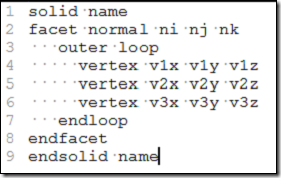
說明如下:

下面給出由Open Cascade中導出的一個長方體的STL文件:
長方體的尺寸為長200,寬150,高100,原點在一個角點上。

Figure 1.1 Box in Open Cascade
 solid solid

 facet normal -1.000000e+000 -0.000000e+000 -0.000000e+000 facet normal -1.000000e+000 -0.000000e+000 -0.000000e+000

 outer loop outer loop

 vertex 0.000000e+000 1.500000e+002 1.000000e+002 vertex 0.000000e+000 1.500000e+002 1.000000e+002

 vertex 0.000000e+000 1.500000e+002 0.000000e+000 vertex 0.000000e+000 1.500000e+002 0.000000e+000

 vertex 0.000000e+000 0.000000e+000 1.000000e+002 vertex 0.000000e+000 0.000000e+000 1.000000e+002

 endloop endloop

 endfacet endfacet

 facet normal -1.000000e+000 0.000000e+000 0.000000e+000 facet normal -1.000000e+000 0.000000e+000 0.000000e+000

 outer loop outer loop

 vertex 0.000000e+000 1.500000e+002 0.000000e+000 vertex 0.000000e+000 1.500000e+002 0.000000e+000

 vertex 0.000000e+000 0.000000e+000 0.000000e+000 vertex 0.000000e+000 0.000000e+000 0.000000e+000

 vertex 0.000000e+000 0.000000e+000 1.000000e+002 vertex 0.000000e+000 0.000000e+000 1.000000e+002

 endloop endloop

 endfacet endfacet

 facet normal 1.000000e+000 -0.000000e+000 0.000000e+000 facet normal 1.000000e+000 -0.000000e+000 0.000000e+000

 outer loop outer loop

 vertex 2.000000e+002 0.000000e+000 1.000000e+002 vertex 2.000000e+002 0.000000e+000 1.000000e+002

 vertex 2.000000e+002 1.500000e+002 0.000000e+000 vertex 2.000000e+002 1.500000e+002 0.000000e+000

 vertex 2.000000e+002 1.500000e+002 1.000000e+002 vertex 2.000000e+002 1.500000e+002 1.000000e+002

 endloop endloop

 endfacet endfacet

 facet normal 1.000000e+000 -0.000000e+000 0.000000e+000 facet normal 1.000000e+000 -0.000000e+000 0.000000e+000

 outer loop outer loop

 vertex 2.000000e+002 0.000000e+000 1.000000e+002 vertex 2.000000e+002 0.000000e+000 1.000000e+002

 vertex 2.000000e+002 0.000000e+000 0.000000e+000 vertex 2.000000e+002 0.000000e+000 0.000000e+000

 vertex 2.000000e+002 1.500000e+002 0.000000e+000 vertex 2.000000e+002 1.500000e+002 0.000000e+000

 endloop endloop

 endfacet endfacet

 facet normal 0.000000e+000 -1.000000e+000 0.000000e+000 facet normal 0.000000e+000 -1.000000e+000 0.000000e+000

 outer loop outer loop

 vertex 0.000000e+000 0.000000e+000 0.000000e+000 vertex 0.000000e+000 0.000000e+000 0.000000e+000

 vertex 2.000000e+002 0.000000e+000 0.000000e+000 vertex 2.000000e+002 0.000000e+000 0.000000e+000

 vertex 2.000000e+002 0.000000e+000 1.000000e+002 vertex 2.000000e+002 0.000000e+000 1.000000e+002

 endloop endloop

 endfacet endfacet

 facet normal 0.000000e+000 -1.000000e+000 0.000000e+000 facet normal 0.000000e+000 -1.000000e+000 0.000000e+000

 outer loop outer loop

 vertex 0.000000e+000 0.000000e+000 1.000000e+002 vertex 0.000000e+000 0.000000e+000 1.000000e+002

 vertex 0.000000e+000 0.000000e+000 0.000000e+000 vertex 0.000000e+000 0.000000e+000 0.000000e+000

 vertex 2.000000e+002 0.000000e+000 1.000000e+002 vertex 2.000000e+002 0.000000e+000 1.000000e+002

 endloop endloop

 endfacet endfacet

 facet normal 0.000000e+000 1.000000e+000 0.000000e+000 facet normal 0.000000e+000 1.000000e+000 0.000000e+000

 outer loop outer loop

 vertex 2.000000e+002 1.500000e+002 1.000000e+002 vertex 2.000000e+002 1.500000e+002 1.000000e+002

 vertex 2.000000e+002 1.500000e+002 0.000000e+000 vertex 2.000000e+002 1.500000e+002 0.000000e+000

 vertex 0.000000e+000 1.500000e+002 0.000000e+000 vertex 0.000000e+000 1.500000e+002 0.000000e+000

 endloop endloop

 endfacet endfacet

 facet normal 0.000000e+000 1.000000e+000 -0.000000e+000 facet normal 0.000000e+000 1.000000e+000 -0.000000e+000

 outer loop outer loop

 vertex 2.000000e+002 1.500000e+002 1.000000e+002 vertex 2.000000e+002 1.500000e+002 1.000000e+002

 vertex 0.000000e+000 1.500000e+002 0.000000e+000 vertex 0.000000e+000 1.500000e+002 0.000000e+000

 vertex 0.000000e+000 1.500000e+002 1.000000e+002 vertex 0.000000e+000 1.500000e+002 1.000000e+002

 endloop endloop

 endfacet endfacet

 facet normal 0.000000e+000 0.000000e+000 -1.000000e+000 facet normal 0.000000e+000 0.000000e+000 -1.000000e+000

 outer loop outer loop

 vertex 0.000000e+000 0.000000e+000 0.000000e+000 vertex 0.000000e+000 0.000000e+000 0.000000e+000

 vertex 0.000000e+000 1.500000e+002 0.000000e+000 vertex 0.000000e+000 1.500000e+002 0.000000e+000

 vertex 2.000000e+002 1.500000e+002 0.000000e+000 vertex 2.000000e+002 1.500000e+002 0.000000e+000

 endloop endloop

 endfacet endfacet

 facet normal 0.000000e+000 0.000000e+000 -1.000000e+000 facet normal 0.000000e+000 0.000000e+000 -1.000000e+000

 outer loop outer loop

 vertex 2.000000e+002 0.000000e+000 0.000000e+000 vertex 2.000000e+002 0.000000e+000 0.000000e+000

 vertex 0.000000e+000 0.000000e+000 0.000000e+000 vertex 0.000000e+000 0.000000e+000 0.000000e+000

 vertex 2.000000e+002 1.500000e+002 0.000000e+000 vertex 2.000000e+002 1.500000e+002 0.000000e+000

 endloop endloop

 endfacet endfacet

 facet normal 0.000000e+000 0.000000e+000 1.000000e+000 facet normal 0.000000e+000 0.000000e+000 1.000000e+000

 outer loop outer loop

 vertex 2.000000e+002 1.500000e+002 1.000000e+002 vertex 2.000000e+002 1.500000e+002 1.000000e+002

 vertex 0.000000e+000 1.500000e+002 1.000000e+002 vertex 0.000000e+000 1.500000e+002 1.000000e+002

 vertex 0.000000e+000 0.000000e+000 1.000000e+002 vertex 0.000000e+000 0.000000e+000 1.000000e+002

 endloop endloop

 endfacet endfacet

 facet normal -0.000000e+000 0.000000e+000 1.000000e+000 facet normal -0.000000e+000 0.000000e+000 1.000000e+000

 outer loop outer loop

 vertex 2.000000e+002 1.500000e+002 1.000000e+002 vertex 2.000000e+002 1.500000e+002 1.000000e+002

 vertex 0.000000e+000 0.000000e+000 1.000000e+002 vertex 0.000000e+000 0.000000e+000 1.000000e+002

 vertex 2.000000e+002 0.000000e+000 1.000000e+002 vertex 2.000000e+002 0.000000e+000 1.000000e+002

 endloop endloop

 endfacet endfacet

 endsolid endsolid


由上面的STL明碼文件可知,上述數據將一個長方體的6個面用12個三角形來表示。在OpenSceneGraph中顯示效果如下圖所示,分別為此長方體的實體渲染模式和線框渲染模式:
 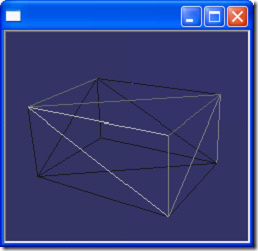
Figure 1.2 Shaded and Wireframe box in OpenSceneGraph
二、STL的二進制(Binary)格式
二進制的STL文件用固定的字節數來給出三角面片的幾何信息。文件起始80個字節是文件頭,用于存貯零件名;緊接著4個字節的整數來描述模型的三角面片個數;后面逐個給出每個三角面片的幾何信息。每個三角面片用固定的50個字節,依次是表示三角面片的法矢量的3個4字節浮點數;表示三角面片三個頂點的3x3個4字節浮點數;最后2個字節用來描述三角面片的屬性信息。
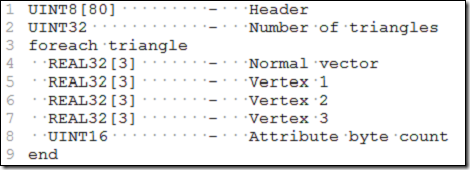
三、OCC中STL文件的讀寫Read/Write STL in Open Cascade
在Open Cascade中STL文件的讀寫分別使用類:StlAPI_Reader/StlAPI_Writer來實現。查看源程序可知,寫STL文件的步驟如下:
l 遍歷一個TopoDS_Shape所有的面Face;
l 使用工具BRep_Tool::Triangulation將每個面Face三角面片化;
l 計算每個三角面片的法矢量;
l 將結果寫入文件。
類RWStl對STL的讀定也是有兩種格式,即ASCII格式和Binary格式:
n RWStl::WriteBinary
n RWStl::WriteAscii
n RWStl::ReadBinary
n RWStl::ReadAscii
程序的具體實現可以查看Open Cascade源代碼,將讀寫部分主要代碼RWStl.cxx列出如下:
 // Created on: 1994-10-13 // Created on: 1994-10-13
 // Created by: Marc LEGAY // Created by: Marc LEGAY
 // Copyright (c) 1994-1999 Matra Datavision // Copyright (c) 1994-1999 Matra Datavision
 // Copyright (c) 1999-2012 OPEN CASCADE SAS // Copyright (c) 1999-2012 OPEN CASCADE SAS
 // //
 // The content of this file is subject to the Open CASCADE Technology Public // The content of this file is subject to the Open CASCADE Technology Public
 // License Version 6.5 (the "License"). You may not use the content of this file // License Version 6.5 (the "License"). You may not use the content of this file
 // except in compliance with the License. Please obtain a copy of the License // except in compliance with the License. Please obtain a copy of the License
 // at http://www.opencascade.org and read it completely before using this file. // at http://www.opencascade.org and read it completely before using this file.
 // //
 // The Initial Developer of the Original Code is Open CASCADE S.A.S., having its // The Initial Developer of the Original Code is Open CASCADE S.A.S., having its
 // main offices at: 1, place des Freres Montgolfier, 78280 Guyancourt, France. // main offices at: 1, place des Freres Montgolfier, 78280 Guyancourt, France.
 // //
 // The Original Code and all software distributed under the License is // The Original Code and all software distributed under the License is
 // distributed on an "AS IS" basis, without warranty of any kind, and the // distributed on an "AS IS" basis, without warranty of any kind, and the
 // Initial Developer hereby disclaims all such warranties, including without // Initial Developer hereby disclaims all such warranties, including without
 // limitation, any warranties of merchantability, fitness for a particular // limitation, any warranties of merchantability, fitness for a particular
 // purpose or non-infringement. Please see the License for the specific terms // purpose or non-infringement. Please see the License for the specific terms
 // and conditions governing the rights and limitations under the License. // and conditions governing the rights and limitations under the License.



 #include <RWStl.ixx> #include <RWStl.ixx>
 #include <OSD_Protection.hxx> #include <OSD_Protection.hxx>
 #include <OSD_File.hxx> #include <OSD_File.hxx>
 #include <Message_ProgressSentry.hxx> #include <Message_ProgressSentry.hxx>
 #include <TCollection_AsciiString.hxx> #include <TCollection_AsciiString.hxx>
 #include <Standard_NoMoreObject.hxx> #include <Standard_NoMoreObject.hxx>
 #include <Standard_TypeMismatch.hxx> #include <Standard_TypeMismatch.hxx>
 #include <Precision.hxx> #include <Precision.hxx>
 #include <StlMesh_MeshExplorer.hxx> #include <StlMesh_MeshExplorer.hxx>
 #include <OSD.hxx> #include <OSD.hxx>
 #include <OSD_Host.hxx> #include <OSD_Host.hxx>
 #include <gp_XYZ.hxx> #include <gp_XYZ.hxx>
 #include <gp.hxx> #include <gp.hxx>
 #include <stdio.h> #include <stdio.h>
 #include <gp_Vec.hxx> #include <gp_Vec.hxx>


 // constants // constants
 static const int HEADER_SIZE = 84; static const int HEADER_SIZE = 84;
 static const int SIZEOF_STL_FACET = 50; static const int SIZEOF_STL_FACET = 50;
 static const int STL_MIN_FILE_SIZE = 284; static const int STL_MIN_FILE_SIZE = 284;
 static const int ASCII_LINES_PER_FACET = 7; static const int ASCII_LINES_PER_FACET = 7;
 static const int IND_THRESHOLD = 1000; // increment the indicator every 1k triangles static const int IND_THRESHOLD = 1000; // increment the indicator every 1k triangles

 //======================================================================= //=======================================================================
 //function : WriteInteger //function : WriteInteger
 //purpose : writing a Little Endian 32 bits integer //purpose : writing a Little Endian 32 bits integer
 //======================================================================= //=======================================================================

 inline static void WriteInteger(OSD_File& ofile,const Standard_Integer value) inline static void WriteInteger(OSD_File& ofile,const Standard_Integer value)
   { {
  union union  { {
 Standard_Integer i;// don't be afraid, this is just an unsigned int Standard_Integer i;// don't be afraid, this is just an unsigned int
 char c[4]; char c[4];
 } bidargum; } bidargum;

 bidargum.i = value; bidargum.i = value;

 Standard_Integer entier; Standard_Integer entier;

 entier = bidargum.c[0] & 0xFF; entier = bidargum.c[0] & 0xFF;
 entier |= (bidargum.c[1] & 0xFF) << 0x08; entier |= (bidargum.c[1] & 0xFF) << 0x08;
 entier |= (bidargum.c[2] & 0xFF) << 0x10; entier |= (bidargum.c[2] & 0xFF) << 0x10;
 entier |= (bidargum.c[3] & 0xFF) << 0x18; entier |= (bidargum.c[3] & 0xFF) << 0x18;

 ofile.Write((char *)&entier,sizeof(bidargum.c)); ofile.Write((char *)&entier,sizeof(bidargum.c));
 } }

 //======================================================================= //=======================================================================
 //function : WriteDouble2Float //function : WriteDouble2Float
 //purpose : writing a Little Endian 32 bits float //purpose : writing a Little Endian 32 bits float
 //======================================================================= //=======================================================================

 inline static void WriteDouble2Float(OSD_File& ofile,Standard_Real value) inline static void WriteDouble2Float(OSD_File& ofile,Standard_Real value)
   { {
  union union  { {
 Standard_ShortReal f; Standard_ShortReal f;
 char c[4]; char c[4];
 } bidargum; } bidargum;

 bidargum.f = (Standard_ShortReal)value; bidargum.f = (Standard_ShortReal)value;

 Standard_Integer entier; Standard_Integer entier;

 entier = bidargum.c[0] & 0xFF; entier = bidargum.c[0] & 0xFF;
 entier |= (bidargum.c[1] & 0xFF) << 0x08; entier |= (bidargum.c[1] & 0xFF) << 0x08;
 entier |= (bidargum.c[2] & 0xFF) << 0x10; entier |= (bidargum.c[2] & 0xFF) << 0x10;
 entier |= (bidargum.c[3] & 0xFF) << 0x18; entier |= (bidargum.c[3] & 0xFF) << 0x18;

 ofile.Write((char *)&entier,sizeof(bidargum.c)); ofile.Write((char *)&entier,sizeof(bidargum.c));
 } }


 //======================================================================= //=======================================================================
 //function : readFloat2Double //function : readFloat2Double
 //purpose : reading a Little Endian 32 bits float //purpose : reading a Little Endian 32 bits float
 //======================================================================= //=======================================================================

 inline static Standard_Real ReadFloat2Double(OSD_File &aFile) inline static Standard_Real ReadFloat2Double(OSD_File &aFile)
   { {
  union union  { {
 Standard_Boolean i; // don't be afraid, this is just an unsigned int Standard_Boolean i; // don't be afraid, this is just an unsigned int
 Standard_ShortReal f; Standard_ShortReal f;
 }bidargum; }bidargum;

 char c[4]; char c[4];
 Standard_Address adr; Standard_Address adr;
 adr = (Standard_Address)c; adr = (Standard_Address)c;
 Standard_Integer lread; Standard_Integer lread;
 aFile.Read(adr,4,lread); aFile.Read(adr,4,lread);
 bidargum.i = c[0] & 0xFF; bidargum.i = c[0] & 0xFF;
 bidargum.i |= (c[1] & 0xFF) << 0x08; bidargum.i |= (c[1] & 0xFF) << 0x08;
 bidargum.i |= (c[2] & 0xFF) << 0x10; bidargum.i |= (c[2] & 0xFF) << 0x10;
 bidargum.i |= (c[3] & 0xFF) << 0x18; bidargum.i |= (c[3] & 0xFF) << 0x18;

 return (Standard_Real)(bidargum.f); return (Standard_Real)(bidargum.f);
 } }



 //======================================================================= //=======================================================================
 //function : WriteBinary //function : WriteBinary
 //purpose : write a binary STL file in Little Endian format //purpose : write a binary STL file in Little Endian format
 //======================================================================= //=======================================================================

 Standard_Boolean RWStl::WriteBinary (const Handle(StlMesh_Mesh)& theMesh, Standard_Boolean RWStl::WriteBinary (const Handle(StlMesh_Mesh)& theMesh,
 const OSD_Path& thePath, const OSD_Path& thePath,
 const Handle(Message_ProgressIndicator)& theProgInd) const Handle(Message_ProgressIndicator)& theProgInd)
   { {
 OSD_File aFile (thePath); OSD_File aFile (thePath);
 aFile.Build (OSD_WriteOnly, OSD_Protection()); aFile.Build (OSD_WriteOnly, OSD_Protection());

 Standard_Real x1, y1, z1; Standard_Real x1, y1, z1;
 Standard_Real x2, y2, z2; Standard_Real x2, y2, z2;
 Standard_Real x3, y3, z3; Standard_Real x3, y3, z3;

 // writing 80 bytes of the trash? // writing 80 bytes of the trash?
 char sval[80]; char sval[80];
 aFile.Write ((Standard_Address)sval,80); aFile.Write ((Standard_Address)sval,80);
 WriteInteger (aFile, theMesh->NbTriangles()); WriteInteger (aFile, theMesh->NbTriangles());

 int dum=0; int dum=0;
 StlMesh_MeshExplorer aMexp (theMesh); StlMesh_MeshExplorer aMexp (theMesh);

 // create progress sentry for domains // create progress sentry for domains
 Standard_Integer aNbDomains = theMesh->NbDomains(); Standard_Integer aNbDomains = theMesh->NbDomains();
 Message_ProgressSentry aDPS (theProgInd, "Mesh domains", 0, aNbDomains, 1); Message_ProgressSentry aDPS (theProgInd, "Mesh domains", 0, aNbDomains, 1);
 for (Standard_Integer nbd = 1; nbd <= aNbDomains && aDPS.More(); nbd++, aDPS.Next()) for (Standard_Integer nbd = 1; nbd <= aNbDomains && aDPS.More(); nbd++, aDPS.Next())
   { {
 // create progress sentry for triangles in domain // create progress sentry for triangles in domain
 Message_ProgressSentry aTPS (theProgInd, "Triangles", 0, Message_ProgressSentry aTPS (theProgInd, "Triangles", 0,
 theMesh->NbTriangles (nbd), IND_THRESHOLD); theMesh->NbTriangles (nbd), IND_THRESHOLD);
 Standard_Integer aTriangleInd = 0; Standard_Integer aTriangleInd = 0;
 for (aMexp.InitTriangle (nbd); aMexp.MoreTriangle(); aMexp.NextTriangle()) for (aMexp.InitTriangle (nbd); aMexp.MoreTriangle(); aMexp.NextTriangle())
   { {
 aMexp.TriangleVertices (x1,y1,z1,x2,y2,z2,x3,y3,z3); aMexp.TriangleVertices (x1,y1,z1,x2,y2,z2,x3,y3,z3);
 //pgo aMexp.TriangleOrientation (x,y,z); //pgo aMexp.TriangleOrientation (x,y,z);
 gp_XYZ Vect12 ((x2-x1), (y2-y1), (z2-z1)); gp_XYZ Vect12 ((x2-x1), (y2-y1), (z2-z1));
 gp_XYZ Vect13 ((x3-x1), (y3-y1), (z3-z1)); gp_XYZ Vect13 ((x3-x1), (y3-y1), (z3-z1));
 gp_XYZ Vnorm = Vect12 ^ Vect13; gp_XYZ Vnorm = Vect12 ^ Vect13;
 Standard_Real Vmodul = Vnorm.Modulus (); Standard_Real Vmodul = Vnorm.Modulus ();
 if (Vmodul > gp::Resolution()) if (Vmodul > gp::Resolution())
   { {
 Vnorm.Divide(Vmodul); Vnorm.Divide(Vmodul);
 } }
 else else
   { {
 // si Vnorm est quasi-nul, on le charge a 0 explicitement // si Vnorm est quasi-nul, on le charge a 0 explicitement
 Vnorm.SetCoord (0., 0., 0.); Vnorm.SetCoord (0., 0., 0.);
 } }

 WriteDouble2Float (aFile, Vnorm.X()); WriteDouble2Float (aFile, Vnorm.X());
 WriteDouble2Float (aFile, Vnorm.Y()); WriteDouble2Float (aFile, Vnorm.Y());
 WriteDouble2Float (aFile, Vnorm.Z()); WriteDouble2Float (aFile, Vnorm.Z());

 WriteDouble2Float (aFile, x1); WriteDouble2Float (aFile, x1);
 WriteDouble2Float (aFile, y1); WriteDouble2Float (aFile, y1);
 WriteDouble2Float (aFile, z1); WriteDouble2Float (aFile, z1);

 WriteDouble2Float (aFile, x2); WriteDouble2Float (aFile, x2);
 WriteDouble2Float (aFile, y2); WriteDouble2Float (aFile, y2);
 WriteDouble2Float (aFile, z2); WriteDouble2Float (aFile, z2);

 WriteDouble2Float (aFile, x3); WriteDouble2Float (aFile, x3);
 WriteDouble2Float (aFile, y3); WriteDouble2Float (aFile, y3);
 WriteDouble2Float (aFile, z3); WriteDouble2Float (aFile, z3);

 aFile.Write (&dum, 2); aFile.Write (&dum, 2);

 // update progress only per 1k triangles // update progress only per 1k triangles
 if (++aTriangleInd % IND_THRESHOLD == 0) if (++aTriangleInd % IND_THRESHOLD == 0)
   { {
 if (!aTPS.More()) if (!aTPS.More())
 break; break;
 aTPS.Next(); aTPS.Next();
 } }
 } }
 } }
 aFile.Close(); aFile.Close();
 Standard_Boolean isInterrupted = !aDPS.More(); Standard_Boolean isInterrupted = !aDPS.More();
 return !isInterrupted; return !isInterrupted;
 } }
 //======================================================================= //=======================================================================
 //function : WriteAscii //function : WriteAscii
 //purpose : write an ASCII STL file //purpose : write an ASCII STL file
 //======================================================================= //=======================================================================

 Standard_Boolean RWStl::WriteAscii (const Handle(StlMesh_Mesh)& theMesh, Standard_Boolean RWStl::WriteAscii (const Handle(StlMesh_Mesh)& theMesh,
 const OSD_Path& thePath, const OSD_Path& thePath,
 const Handle(Message_ProgressIndicator)& theProgInd) const Handle(Message_ProgressIndicator)& theProgInd)
   { {
 OSD_File theFile (thePath); OSD_File theFile (thePath);
 theFile.Build(OSD_WriteOnly,OSD_Protection()); theFile.Build(OSD_WriteOnly,OSD_Protection());
 TCollection_AsciiString buf ("solid\n"); TCollection_AsciiString buf ("solid\n");
 theFile.Write (buf,buf.Length());buf.Clear(); theFile.Write (buf,buf.Length());buf.Clear();

 Standard_Real x1, y1, z1; Standard_Real x1, y1, z1;
 Standard_Real x2, y2, z2; Standard_Real x2, y2, z2;
 Standard_Real x3, y3, z3; Standard_Real x3, y3, z3;
 char sval[512]; char sval[512];

 // create progress sentry for domains // create progress sentry for domains
 Standard_Integer aNbDomains = theMesh->NbDomains(); Standard_Integer aNbDomains = theMesh->NbDomains();
 Message_ProgressSentry aDPS (theProgInd, "Mesh domains", 0, aNbDomains, 1); Message_ProgressSentry aDPS (theProgInd, "Mesh domains", 0, aNbDomains, 1);
 StlMesh_MeshExplorer aMexp (theMesh); StlMesh_MeshExplorer aMexp (theMesh);
 for (Standard_Integer nbd = 1; nbd <= aNbDomains && aDPS.More(); nbd++, aDPS.Next()) for (Standard_Integer nbd = 1; nbd <= aNbDomains && aDPS.More(); nbd++, aDPS.Next())
   { {
 // create progress sentry for triangles in domain // create progress sentry for triangles in domain
 Message_ProgressSentry aTPS (theProgInd, "Triangles", 0, Message_ProgressSentry aTPS (theProgInd, "Triangles", 0,
 theMesh->NbTriangles (nbd), IND_THRESHOLD); theMesh->NbTriangles (nbd), IND_THRESHOLD);
 Standard_Integer aTriangleInd = 0; Standard_Integer aTriangleInd = 0;
 for (aMexp.InitTriangle (nbd); aMexp.MoreTriangle(); aMexp.NextTriangle()) for (aMexp.InitTriangle (nbd); aMexp.MoreTriangle(); aMexp.NextTriangle())
   { {
 aMexp.TriangleVertices (x1,y1,z1,x2,y2,z2,x3,y3,z3); aMexp.TriangleVertices (x1,y1,z1,x2,y2,z2,x3,y3,z3);

 // Standard_Real x, y, z; // Standard_Real x, y, z;
 // aMexp.TriangleOrientation (x,y,z); // aMexp.TriangleOrientation (x,y,z);

 gp_XYZ Vect12 ((x2-x1), (y2-y1), (z2-z1)); gp_XYZ Vect12 ((x2-x1), (y2-y1), (z2-z1));
 gp_XYZ Vect23 ((x3-x2), (y3-y2), (z3-z2)); gp_XYZ Vect23 ((x3-x2), (y3-y2), (z3-z2));
 gp_XYZ Vnorm = Vect12 ^ Vect23; gp_XYZ Vnorm = Vect12 ^ Vect23;
 Standard_Real Vmodul = Vnorm.Modulus (); Standard_Real Vmodul = Vnorm.Modulus ();
 if (Vmodul > gp::Resolution()) if (Vmodul > gp::Resolution())
   { {
 Vnorm.Divide (Vmodul); Vnorm.Divide (Vmodul);
 } }
 else else
   { {
 // si Vnorm est quasi-nul, on le charge a 0 explicitement // si Vnorm est quasi-nul, on le charge a 0 explicitement
 Vnorm.SetCoord (0., 0., 0.); Vnorm.SetCoord (0., 0., 0.);
 } }
 sprintf (sval, sprintf (sval,
 " facet normal % 12e % 12e % 12e\n" " facet normal % 12e % 12e % 12e\n"
 " outer loop\n" " outer loop\n"
 " vertex % 12e % 12e % 12e\n" " vertex % 12e % 12e % 12e\n"
 " vertex % 12e % 12e % 12e\n" " vertex % 12e % 12e % 12e\n"
 " vertex % 12e % 12e % 12e\n" " vertex % 12e % 12e % 12e\n"
 " endloop\n" " endloop\n"
 " endfacet\n", " endfacet\n",
 Vnorm.X(), Vnorm.Y(), Vnorm.Z(), Vnorm.X(), Vnorm.Y(), Vnorm.Z(),
 x1, y1, z1, x1, y1, z1,
 x2, y2, z2, x2, y2, z2,
 x3, y3, z3); x3, y3, z3);
 buf += sval; buf += sval;
 theFile.Write (buf, buf.Length()); buf.Clear(); theFile.Write (buf, buf.Length()); buf.Clear();

 // update progress only per 1k triangles // update progress only per 1k triangles
 if (++aTriangleInd % IND_THRESHOLD == 0) if (++aTriangleInd % IND_THRESHOLD == 0)
   { {
 if (!aTPS.More()) if (!aTPS.More())
 break; break;
 aTPS.Next(); aTPS.Next();
 } }
 } }
 } }

 buf += "endsolid\n"; buf += "endsolid\n";
 theFile.Write (buf, buf.Length()); buf.Clear(); theFile.Write (buf, buf.Length()); buf.Clear();
 theFile.Close(); theFile.Close();
 Standard_Boolean isInterrupted = !aDPS.More(); Standard_Boolean isInterrupted = !aDPS.More();
 return !isInterrupted; return !isInterrupted;
 } }
 //======================================================================= //=======================================================================
 //function : ReadFile //function : ReadFile
 //Design : //Design :
 //Warning : //Warning :
 //======================================================================= //=======================================================================

 Handle_StlMesh_Mesh RWStl::ReadFile (const OSD_Path& thePath, Handle_StlMesh_Mesh RWStl::ReadFile (const OSD_Path& thePath,
 const Handle(Message_ProgressIndicator)& theProgInd) const Handle(Message_ProgressIndicator)& theProgInd)
   { {
 OSD_File file (thePath); OSD_File file (thePath);
 file.Open(OSD_ReadOnly,OSD_Protection(OSD_RWD,OSD_RWD,OSD_RWD,OSD_RWD)); file.Open(OSD_ReadOnly,OSD_Protection(OSD_RWD,OSD_RWD,OSD_RWD,OSD_RWD));
 Standard_Boolean IsAscii; Standard_Boolean IsAscii;
 unsigned char str[128]; unsigned char str[128];
 Standard_Integer lread,i; Standard_Integer lread,i;
 Standard_Address ach; Standard_Address ach;
 ach = (Standard_Address)str; ach = (Standard_Address)str;

 // we skip the header which is in Ascii for both modes // we skip the header which is in Ascii for both modes
 file.Read(ach,HEADER_SIZE,lread); file.Read(ach,HEADER_SIZE,lread);

 // we read 128 characters to detect if we have a non-ascii char // we read 128 characters to detect if we have a non-ascii char
 file.Read(ach,sizeof(str),lread); file.Read(ach,sizeof(str),lread);

 IsAscii = Standard_True; IsAscii = Standard_True;
  for (i = 0; i< lread && IsAscii; ++i) for (i = 0; i< lread && IsAscii; ++i)  { {
  if (str[i] > '~') if (str[i] > '~')  { {
 IsAscii = Standard_False; IsAscii = Standard_False;
 } }
 } }
 #ifdef DEB #ifdef DEB
 cout << (IsAscii ? "ascii\n" : "binary\n"); cout << (IsAscii ? "ascii\n" : "binary\n");
 #endif #endif
 file.Close(); file.Close();

 return IsAscii ? RWStl::ReadAscii (thePath, theProgInd) return IsAscii ? RWStl::ReadAscii (thePath, theProgInd)
 : RWStl::ReadBinary (thePath, theProgInd); : RWStl::ReadBinary (thePath, theProgInd);
 } }

 //======================================================================= //=======================================================================
 //function : ReadBinary //function : ReadBinary
 //Design : //Design :
 //Warning : //Warning :
 //======================================================================= //=======================================================================

 Handle_StlMesh_Mesh RWStl::ReadBinary (const OSD_Path& thePath, Handle_StlMesh_Mesh RWStl::ReadBinary (const OSD_Path& thePath,
  const Handle(Message_ProgressIndicator)& /**//*theProgInd*/) const Handle(Message_ProgressIndicator)& /**//*theProgInd*/)
   { {
 Standard_Integer NBFACET; Standard_Integer NBFACET;
 Standard_Integer ifacet; Standard_Integer ifacet;
 Standard_Real fx,fy,fz,fx1,fy1,fz1,fx2,fy2,fz2,fx3,fy3,fz3; Standard_Real fx,fy,fz,fx1,fy1,fz1,fx2,fy2,fz2,fx3,fy3,fz3;
 Standard_Integer i1,i2,i3,lread; Standard_Integer i1,i2,i3,lread;
 char buftest[5]; char buftest[5];
 Standard_Address adr; Standard_Address adr;
 adr = (Standard_Address)buftest; adr = (Standard_Address)buftest;

 // Open the file // Open the file
 OSD_File theFile (thePath); OSD_File theFile (thePath);
 theFile.Open(OSD_ReadOnly,OSD_Protection(OSD_RWD,OSD_RWD,OSD_RWD,OSD_RWD)); theFile.Open(OSD_ReadOnly,OSD_Protection(OSD_RWD,OSD_RWD,OSD_RWD,OSD_RWD));

 // the size of the file (minus the header size) // the size of the file (minus the header size)
 // must be a multiple of SIZEOF_STL_FACET // must be a multiple of SIZEOF_STL_FACET

 // compute file size // compute file size
 Standard_Integer filesize = theFile.Size(); Standard_Integer filesize = theFile.Size();

 if ( (filesize - HEADER_SIZE) % SIZEOF_STL_FACET !=0 if ( (filesize - HEADER_SIZE) % SIZEOF_STL_FACET !=0
  || (filesize < STL_MIN_FILE_SIZE)) || (filesize < STL_MIN_FILE_SIZE))  { {
 Standard_NoMoreObject::Raise("RWStl::ReadBinary (wrong file size)"); Standard_NoMoreObject::Raise("RWStl::ReadBinary (wrong file size)");
 } }

 // don't trust the number of triangles which is coded in the file // don't trust the number of triangles which is coded in the file
 // sometimes it is wrong, and with this technique we don't need to swap endians for integer // sometimes it is wrong, and with this technique we don't need to swap endians for integer
 NBFACET = ((filesize - HEADER_SIZE) / SIZEOF_STL_FACET); NBFACET = ((filesize - HEADER_SIZE) / SIZEOF_STL_FACET);

 // skip the header // skip the header
 theFile.Seek(HEADER_SIZE,OSD_FromBeginning); theFile.Seek(HEADER_SIZE,OSD_FromBeginning);

 // create the StlMesh_Mesh object // create the StlMesh_Mesh object
 Handle(StlMesh_Mesh) ReadMesh = new StlMesh_Mesh (); Handle(StlMesh_Mesh) ReadMesh = new StlMesh_Mesh ();
 ReadMesh->AddDomain (); ReadMesh->AddDomain ();

  for (ifacet=1; ifacet<=NBFACET; ++ifacet) for (ifacet=1; ifacet<=NBFACET; ++ifacet)  { {
 // read normal coordinates // read normal coordinates
 fx = ReadFloat2Double(theFile); fx = ReadFloat2Double(theFile);
 fy = ReadFloat2Double(theFile); fy = ReadFloat2Double(theFile);
 fz = ReadFloat2Double(theFile); fz = ReadFloat2Double(theFile);

 // read vertex 1 // read vertex 1
 fx1 = ReadFloat2Double(theFile); fx1 = ReadFloat2Double(theFile);
 fy1 = ReadFloat2Double(theFile); fy1 = ReadFloat2Double(theFile);
 fz1 = ReadFloat2Double(theFile); fz1 = ReadFloat2Double(theFile);

 // read vertex 2 // read vertex 2
 fx2 = ReadFloat2Double(theFile); fx2 = ReadFloat2Double(theFile);
 fy2 = ReadFloat2Double(theFile); fy2 = ReadFloat2Double(theFile);
 fz2 = ReadFloat2Double(theFile); fz2 = ReadFloat2Double(theFile);

 // read vertex 3 // read vertex 3
 fx3 = ReadFloat2Double(theFile); fx3 = ReadFloat2Double(theFile);
 fy3 = ReadFloat2Double(theFile); fy3 = ReadFloat2Double(theFile);
 fz3 = ReadFloat2Double(theFile); fz3 = ReadFloat2Double(theFile);

 i1 = ReadMesh->AddOnlyNewVertex (fx1,fy1,fz1); i1 = ReadMesh->AddOnlyNewVertex (fx1,fy1,fz1);
 i2 = ReadMesh->AddOnlyNewVertex (fx2,fy2,fz2); i2 = ReadMesh->AddOnlyNewVertex (fx2,fy2,fz2);
 i3 = ReadMesh->AddOnlyNewVertex (fx3,fy3,fz3); i3 = ReadMesh->AddOnlyNewVertex (fx3,fy3,fz3);
 ReadMesh->AddTriangle (i1,i2,i3,fx,fy,fz); ReadMesh->AddTriangle (i1,i2,i3,fx,fy,fz);

 // skip extra bytes // skip extra bytes
 theFile.Read(adr,2,lread); theFile.Read(adr,2,lread);
 } }

 theFile.Close (); theFile.Close ();
 return ReadMesh; return ReadMesh;

 } }
 //======================================================================= //=======================================================================
 //function : ReadAscii //function : ReadAscii
 //Design : //Design :
 //Warning : //Warning :
 //======================================================================= //=======================================================================

 Handle_StlMesh_Mesh RWStl::ReadAscii (const OSD_Path& thePath, Handle_StlMesh_Mesh RWStl::ReadAscii (const OSD_Path& thePath,
 const Handle(Message_ProgressIndicator)& theProgInd) const Handle(Message_ProgressIndicator)& theProgInd)
   { {
 TCollection_AsciiString filename; TCollection_AsciiString filename;
 long ipos; long ipos;
 Standard_Integer nbLines = 0; Standard_Integer nbLines = 0;
 Standard_Integer nbTris = 0; Standard_Integer nbTris = 0;
 Standard_Integer iTri; Standard_Integer iTri;
 Standard_ShortReal x[4],y[4],z[4]; Standard_ShortReal x[4],y[4],z[4];
 Standard_Integer i1,i2,i3; Standard_Integer i1,i2,i3;
 Handle(StlMesh_Mesh) ReadMesh; Handle(StlMesh_Mesh) ReadMesh;

 thePath.SystemName (filename); thePath.SystemName (filename);

 // Open the file // Open the file
 FILE* file = fopen(filename.ToCString(),"r"); FILE* file = fopen(filename.ToCString(),"r");

 fseek(file,0L,SEEK_END); fseek(file,0L,SEEK_END);

 long filesize = ftell(file); long filesize = ftell(file);

 fclose(file); fclose(file);
 file = fopen(filename.ToCString(),"r"); file = fopen(filename.ToCString(),"r");



 // count the number of lines // count the number of lines
  for (ipos = 0; ipos < filesize; ++ipos) for (ipos = 0; ipos < filesize; ++ipos)  { {
 if (getc(file) == '\n') if (getc(file) == '\n')
 nbLines++; nbLines++;
 } }

 // compute number of triangles // compute number of triangles
 nbTris = (nbLines / ASCII_LINES_PER_FACET); nbTris = (nbLines / ASCII_LINES_PER_FACET);

 // go back to the beginning of the file // go back to the beginning of the file
 // fclose(file); // fclose(file);
 // file = fopen(filename.ToCString(),"r"); // file = fopen(filename.ToCString(),"r");
 rewind(file); rewind(file);

 // skip header // skip header
 while (getc(file) != '\n'); while (getc(file) != '\n');
 #ifdef DEB #ifdef DEB
 cout << "start mesh\n"; cout << "start mesh\n";
 #endif #endif
 ReadMesh = new StlMesh_Mesh(); ReadMesh = new StlMesh_Mesh();
 ReadMesh->AddDomain(); ReadMesh->AddDomain();

 // main reading // main reading
 Message_ProgressSentry aPS (theProgInd, "Triangles", 0, (nbTris - 1) * 1.0 / IND_THRESHOLD, 1); Message_ProgressSentry aPS (theProgInd, "Triangles", 0, (nbTris - 1) * 1.0 / IND_THRESHOLD, 1);
 for (iTri = 0; iTri < nbTris && aPS.More();) for (iTri = 0; iTri < nbTris && aPS.More();)
   { {
 // reading the facet normal // reading the facet normal
 fscanf(file,"%*s %*s %f %f %f\n",&x[0],&y[0],&z[0]); fscanf(file,"%*s %*s %f %f %f\n",&x[0],&y[0],&z[0]);

 // skip the keywords "outer loop" // skip the keywords "outer loop"
 fscanf(file,"%*s %*s"); fscanf(file,"%*s %*s");

 // reading vertex // reading vertex
 fscanf(file,"%*s %f %f %f\n",&x[1],&y[1],&z[1]); fscanf(file,"%*s %f %f %f\n",&x[1],&y[1],&z[1]);
 fscanf(file,"%*s %f %f %f\n",&x[2],&y[2],&z[2]); fscanf(file,"%*s %f %f %f\n",&x[2],&y[2],&z[2]);
 fscanf(file,"%*s %f %f %f\n",&x[3],&y[3],&z[3]); fscanf(file,"%*s %f %f %f\n",&x[3],&y[3],&z[3]);

 // here the facet must be built and put in the mesh datastructure // here the facet must be built and put in the mesh datastructure

 i1 = ReadMesh->AddOnlyNewVertex ((Standard_Real)x[1],(Standard_Real)y[1],(Standard_Real)z[1]); i1 = ReadMesh->AddOnlyNewVertex ((Standard_Real)x[1],(Standard_Real)y[1],(Standard_Real)z[1]);
 i2 = ReadMesh->AddOnlyNewVertex ((Standard_Real)x[2],(Standard_Real)y[2],(Standard_Real)z[2]); i2 = ReadMesh->AddOnlyNewVertex ((Standard_Real)x[2],(Standard_Real)y[2],(Standard_Real)z[2]);
 i3 = ReadMesh->AddOnlyNewVertex ((Standard_Real)x[3],(Standard_Real)y[3],(Standard_Real)z[3]); i3 = ReadMesh->AddOnlyNewVertex ((Standard_Real)x[3],(Standard_Real)y[3],(Standard_Real)z[3]);
 ReadMesh->AddTriangle (i1,i2,i3,(Standard_Real)x[0],(Standard_Real)y[0],(Standard_Real)z[0]); ReadMesh->AddTriangle (i1,i2,i3,(Standard_Real)x[0],(Standard_Real)y[0],(Standard_Real)z[0]);

 // skip the keywords "endloop" // skip the keywords "endloop"
 fscanf(file,"%*s"); fscanf(file,"%*s");

 // skip the keywords "endfacet" // skip the keywords "endfacet"
 fscanf(file,"%*s"); fscanf(file,"%*s");

 // update progress only per 1k triangles // update progress only per 1k triangles
 if (++iTri % IND_THRESHOLD == 0) if (++iTri % IND_THRESHOLD == 0)
 aPS.Next(); aPS.Next();
 } }
 #ifdef DEB #ifdef DEB
 cout << "end mesh\n"; cout << "end mesh\n";
 #endif #endif
 fclose(file); fclose(file);
 return ReadMesh; return ReadMesh;

 } }

程序開始定義了一些常量:
 // constants // constants
 static const int HEADER_SIZE = 84; static const int HEADER_SIZE = 84;
 static const int SIZEOF_STL_FACET = 50; static const int SIZEOF_STL_FACET = 50;
 static const int STL_MIN_FILE_SIZE = 284; static const int STL_MIN_FILE_SIZE = 284;
 static const int ASCII_LINES_PER_FACET = 7; static const int ASCII_LINES_PER_FACET = 7;
 static const int IND_THRESHOLD = 1000; // increment the indicator every 1k triangles static const int IND_THRESHOLD = 1000; // increment the indicator every 1k triangles

分別對應二進制文件中相關信息,即文件頭84個字節,每個三角面片50個字節,STL文件最小為284字節。ASCII的STL中每個三角面有7行。
在數據的讀寫過程中,對數據進行了小端轉換。將double數據轉換成小端表示的代碼如下所示:
 //======================================================================= //=======================================================================
 //function : WriteDouble2Float //function : WriteDouble2Float
 //purpose : writing a Little Endian 32 bits float //purpose : writing a Little Endian 32 bits float
 //======================================================================= //=======================================================================

 inline static void WriteDouble2Float(OSD_File& ofile,Standard_Real value) inline static void WriteDouble2Float(OSD_File& ofile,Standard_Real value)
   { {
  union union  { {
 Standard_ShortReal f; Standard_ShortReal f;
 char c[4]; char c[4];
 } bidargum; } bidargum;

 bidargum.f = (Standard_ShortReal)value; bidargum.f = (Standard_ShortReal)value;

 Standard_Integer entier; Standard_Integer entier;

 entier = bidargum.c[0] & 0xFF; entier = bidargum.c[0] & 0xFF;
 entier |= (bidargum.c[1] & 0xFF) << 0x08; entier |= (bidargum.c[1] & 0xFF) << 0x08;
 entier |= (bidargum.c[2] & 0xFF) << 0x10; entier |= (bidargum.c[2] & 0xFF) << 0x10;
 entier |= (bidargum.c[3] & 0xFF) << 0x18; entier |= (bidargum.c[3] & 0xFF) << 0x18;

 ofile.Write((char *)&entier,sizeof(bidargum.c)); ofile.Write((char *)&entier,sizeof(bidargum.c));
 } }
使用聯合體(union)來處理顯得很優雅。關于大端、小端的相關信息請參考:
http://www.shnenglu.com/tx7do/archive/2009/01/06/71276.html
四、在OpenSceneGraph中顯示STL
結合OpenCascade中對STL文件讀寫的功能和OpenSceneGraph的顯示功能,將STL讀取所得數據進行顯示。源程序如下所示:

 // Open Cascade // Open Cascade
 #include <gp_Vec.hxx> #include <gp_Vec.hxx>
 #include <OSD_Path.hxx> #include <OSD_Path.hxx>
 #include <RWStl.hxx> #include <RWStl.hxx>
 #include <StlMesh_Mesh.hxx> #include <StlMesh_Mesh.hxx>
 #include <StlMesh_MeshExplorer.hxx> #include <StlMesh_MeshExplorer.hxx>

 #pragma comment(lib, "TKernel.lib") #pragma comment(lib, "TKernel.lib")
 #pragma comment(lib, "TKMath.lib") #pragma comment(lib, "TKMath.lib")
 #pragma comment(lib, "TKSTL.lib") #pragma comment(lib, "TKSTL.lib")

 // OpenSceneGraph // OpenSceneGraph
 #include <osgDB/ReadFile> #include <osgDB/ReadFile>
 #include <osgViewer/Viewer> #include <osgViewer/Viewer>
 #include <osgViewer/ViewerEventHandlers> #include <osgViewer/ViewerEventHandlers>
 #include <osgGA/StateSetManipulator> #include <osgGA/StateSetManipulator>

 #pragma comment(lib, "osgd.lib") #pragma comment(lib, "osgd.lib")
 #pragma comment(lib, "osgDbd.lib") #pragma comment(lib, "osgDbd.lib")
 #pragma comment(lib, "osgGAd.lib") #pragma comment(lib, "osgGAd.lib")
 #pragma comment(lib, "osgViewerd.lib") #pragma comment(lib, "osgViewerd.lib")

 osg::Node* readSTLFile(const std::string& fileName) osg::Node* readSTLFile(const std::string& fileName)
   { {
 osg::Group* root = new osg::Group(); osg::Group* root = new osg::Group();

 OSD_Path stlFile(fileName.c_str()); OSD_Path stlFile(fileName.c_str());
 Handle_StlMesh_Mesh stlMesh = RWStl::ReadFile(stlFile); Handle_StlMesh_Mesh stlMesh = RWStl::ReadFile(stlFile);
 Standard_Integer nDomains = stlMesh->NbDomains(); Standard_Integer nDomains = stlMesh->NbDomains();
 StlMesh_MeshExplorer meshExplorer(stlMesh); StlMesh_MeshExplorer meshExplorer(stlMesh);

  Standard_Real x[3] = Standard_Real x[3] =  {0}; {0};
  Standard_Real y[3] = Standard_Real y[3] =  {0}; {0};
  Standard_Real z[3] = Standard_Real z[3] =  {0}; {0};
  Standard_Real n[3] = Standard_Real n[3] =  {0}; {0};

 gp_XYZ p1; gp_XYZ p1;
 gp_XYZ p2; gp_XYZ p2;
 gp_XYZ p3; gp_XYZ p3;
 gp_XYZ normal; gp_XYZ normal;
 gp_Vec vecNormal; gp_Vec vecNormal;

 for (int i = 1; i <= nDomains; i++) for (int i = 1; i <= nDomains; i++)
   { {
 for (meshExplorer.InitTriangle(i); meshExplorer.MoreTriangle(); meshExplorer.NextTriangle()) for (meshExplorer.InitTriangle(i); meshExplorer.MoreTriangle(); meshExplorer.NextTriangle())
   { {
 meshExplorer.TriangleVertices(x[0], y[0], z[0], x[1], y[1], z[1], x[2], y[2], z[2]); meshExplorer.TriangleVertices(x[0], y[0], z[0], x[1], y[1], z[1], x[2], y[2], z[2]);
 meshExplorer.TriangleOrientation(n[0], n[1], n[2]); meshExplorer.TriangleOrientation(n[0], n[1], n[2]);

 p1.SetCoord(x[0], y[0], z[0]); p1.SetCoord(x[0], y[0], z[0]);
 p2.SetCoord(x[1], y[1], z[1]); p2.SetCoord(x[1], y[1], z[1]);
 p3.SetCoord(x[2], y[2], z[2]); p3.SetCoord(x[2], y[2], z[2]);
 normal.SetCoord(n[0], n[1], n[2]); normal.SetCoord(n[0], n[1], n[2]);

 //gp_Vec vec12((x[1] - x[0]), (y[1] - y[0]), (z[1] - z[0])); //gp_Vec vec12((x[1] - x[0]), (y[1] - y[0]), (z[1] - z[0]));
 //gp_Vec vec23((x[2] - x[1]), (y[2] - y[1]), (z[2] - z[1])); //gp_Vec vec23((x[2] - x[1]), (y[2] - y[1]), (z[2] - z[1]));
 //vecNormal = vec12.Crossed(vec23).Normalized(); //vecNormal = vec12.Crossed(vec23).Normalized();

 osg::ref_ptr<osg::Geode> geode = new osg::Geode(); osg::ref_ptr<osg::Geode> geode = new osg::Geode();
 osg::ref_ptr<osg::Geometry> triGeom = new osg::Geometry(); osg::ref_ptr<osg::Geometry> triGeom = new osg::Geometry();
 osg::ref_ptr<osg::Vec3Array> vertices = new osg::Vec3Array(); osg::ref_ptr<osg::Vec3Array> vertices = new osg::Vec3Array();
 osg::ref_ptr<osg::Vec3Array> normals = new osg::Vec3Array(); osg::ref_ptr<osg::Vec3Array> normals = new osg::Vec3Array();

 vertices->push_back(osg::Vec3(x[0], y[0], z[0])); vertices->push_back(osg::Vec3(x[0], y[0], z[0]));
 vertices->push_back(osg::Vec3(x[1], y[1], z[1])); vertices->push_back(osg::Vec3(x[1], y[1], z[1]));
 vertices->push_back(osg::Vec3(x[2], y[2], z[2])); vertices->push_back(osg::Vec3(x[2], y[2], z[2]));

 normals->push_back(osg::Vec3(n[0], n[1], n[2])); normals->push_back(osg::Vec3(n[0], n[1], n[2]));

 triGeom->setVertexArray(vertices.get()); triGeom->setVertexArray(vertices.get());
 triGeom->addPrimitiveSet(new osg::DrawArrays(osg::PrimitiveSet::TRIANGLES, 0, vertices->size())); triGeom->addPrimitiveSet(new osg::DrawArrays(osg::PrimitiveSet::TRIANGLES, 0, vertices->size()));

 triGeom->setNormalArray(normals); triGeom->setNormalArray(normals);
 triGeom->setNormalBinding(osg::Geometry::BIND_PER_PRIMITIVE); triGeom->setNormalBinding(osg::Geometry::BIND_PER_PRIMITIVE);

 geode->addDrawable(triGeom); geode->addDrawable(triGeom);

 root->addChild(geode); root->addChild(geode);
 } }
 } }

 return root; return root;
 } }

 int main(int argc, char* argv[]) int main(int argc, char* argv[])
   { {
 osgViewer::Viewer myViewer; osgViewer::Viewer myViewer;
 osg::ref_ptr<osg::Group> root = new osg::Group(); osg::ref_ptr<osg::Group> root = new osg::Group();

 //root->addChild(readSTLFile("D:\\OpenCASCADE6.5.0\\data\\stl\\propeller.stl")); //root->addChild(readSTLFile("D:\\OpenCASCADE6.5.0\\data\\stl\\propeller.stl"));
 root->addChild(readSTLFile("D:\\OpenCASCADE6.5.0\\data\\stl\\sh1.stl")); root->addChild(readSTLFile("D:\\OpenCASCADE6.5.0\\data\\stl\\sh1.stl"));
 //root->addChild(readSTLFile("D:\\OpenCASCADE6.5.0\\data\\stl\\motor.stl")); //root->addChild(readSTLFile("D:\\OpenCASCADE6.5.0\\data\\stl\\motor.stl"));
 //root->addChild(readSTLFile("D:\\box.stl")); //root->addChild(readSTLFile("D:\\box.stl"));

 myViewer.setSceneData(root); myViewer.setSceneData(root);

 myViewer.addEventHandler(new osgGA::StateSetManipulator(myViewer.getCamera()->getOrCreateStateSet())); myViewer.addEventHandler(new osgGA::StateSetManipulator(myViewer.getCamera()->getOrCreateStateSet()));
 myViewer.addEventHandler(new osgViewer::StatsHandler); myViewer.addEventHandler(new osgViewer::StatsHandler);
 myViewer.addEventHandler(new osgViewer::WindowSizeHandler); myViewer.addEventHandler(new osgViewer::WindowSizeHandler);

 return myViewer.run(); return myViewer.run();
 } }
以下所示為OpenCascade提供的幾個STL文件在OpenSceneGraph中顯示的效果:
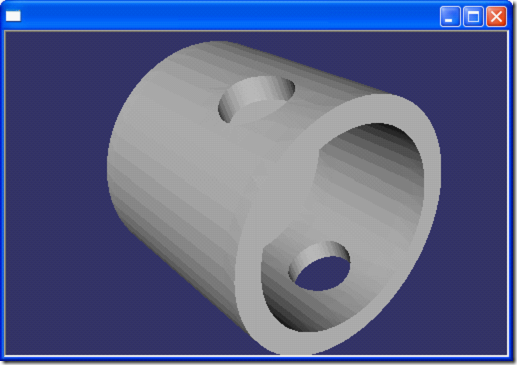
Figure 4.1 Shaded Piston
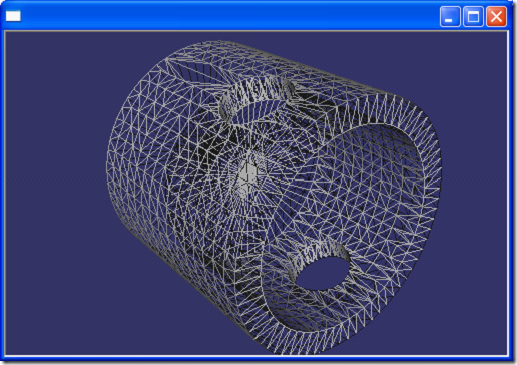
Figure 4.2 Wireframe Piston
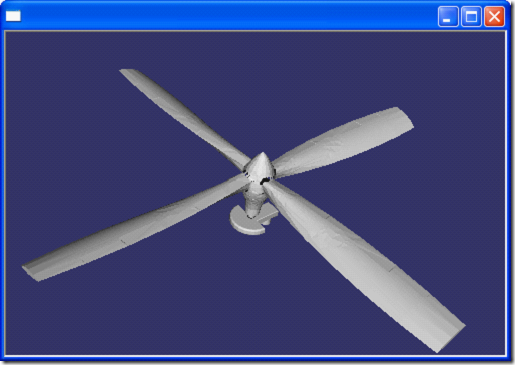
Figure 4.3 Shaded Propeller
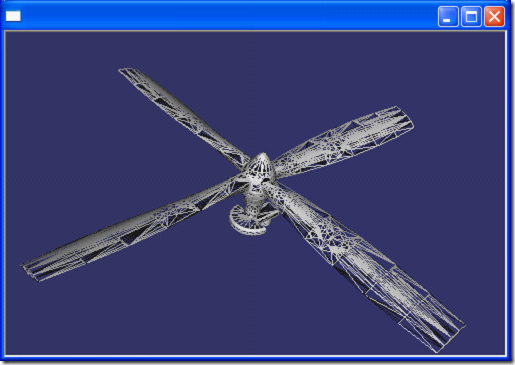
Figure 4.4 Wireframe Propeller
五、結論
通過使用OpenCascade的類RWStl來讀取STL格式的文件,理解了STL文件格式;通過將讀取的三角面面片數據在OpenSceneGraph中顯示,對三維物體在計算機中的表示有了感性的認識。
六、參考資料
1. OpenCascade中類RWStl.cxx
2. OpenCascade中STL模型數據
3. 字節序、大端、小端:http://www.shnenglu.com/tx7do/archive/2009/01/06/71276.html
Feedback
# re: Open Cascade Data Exchange --- STL 回復 更多評論
2018-09-05 20:00 by
博主您好,我如何在opencascade里讀取.sat文件?
# re: Open Cascade Data Exchange --- STL 回復 更多評論
2018-09-05 20:09 by
@birds
opencascade開源部分沒有這個功能,要么使用他收費的模塊,,要么使用其他SDK。
|